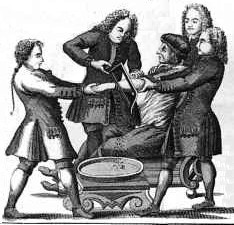
Amputation Page Menu: 1 2 3 4 5 6 7 8 9 10 11 12 Next>>
Amputation During the Golden Age of Piracy, Page 1
"…by a Shot from that Ship [British Royal Navy Ship Swallow], he [pirate John Walden] lost his Leg, his Behaviour in the Fight, till then being bold and daring." - Captain Charles Johnson, The Life of Captain Bartholomew Roberts'
Amputation and its result, the prosthetic, have long been associated with pirates. Many people, when dressing as a pirate for Hallowe'en cast their thoughts to the traditional pirate hook - in place of a hand - or a peg leg - in place of a leg. These, combined with the eye patch are almost de riguer for a pirate costume.

Amputated soldier from "The Polling" of the Humours of the
Election series by William Hogarth, 1754-5
Interestingly we have no accounts of pirates with prosthetic arms or hands and only one account of which I've been made aware of a pirate with a peg leg. Our peg-legged pirate is not John Walden who was later found at
trial being "rather solicitous about resting his Stump, than giving any Answer to the Court, or
making any Defence for himself." 1
No, our wooden appendaged pirate is mentioned only in passing in the General History
in the account of pirate captain Edward England. Johnson doesn't even deign to name him, describing him
as "…a fellow with a terrible pair of Whiskers, and a wooden Leg, being stuck round with Pistols,
like a Man in the Almanack with Darts..."2 So the hook and peg leg association to
piracy may have more to do with the imaginations of Peter Pan author James Barrie and
Treasure Island author Robert Louis Stevenson than actual pirate history.
Still, it probably would not have been uncommon to find a pirate with a peg leg or prosthetic arm. In fact, these things would likely be found among any group of men who had served in battle including sailors and soldiers. Nor was amputation limited to such people. Reading through many different surgical author's accounts, I have found stories of amputations on maids, builders, gentlemen and even minor nobility!
Jonathan Charles Goddard explains that, "Amputation of a limb with speed and efficiency was the measure of a naval surgeon."3 This becomes poignant when you remember that they didn't have any means of anesthetizing a patient during an operation. Tony Harrison comments, "The difference to today was the sheer speed at which these operations were completed. A competent surgeon of the time would complete [an amputation] in considerably less than two minutes. They knew that not allowing for any compromise on their skill factor, the quicker these operations were completed the better chance of a full recovery for the patient".4
It is striking how important this operation was regarded as being during this period. Every surgical author I have read has something to say on the topic, as we'll see shortly. To a man, they describe their procedure. It was an important operation to be able to perform well. For, as Goddard also explains, it was "...termed a "capital" operation – an indication of its considerable mortality."5
1 Captain Charles Johnson, The General History of the Most Notorious Pirates, p. 307; 2 Johnson, p. 123; 3 Jonathan Charles Goddard, "The navy surgeon's chest: surgical instruments of the Royal Navy during the Napoleonic War," Journal of the Royal Society of Medicine, April 2004, page 192; 4 Tony Harrison, "Nelson and his Navy – Surgery in the Royal Navy," The Historical Maritime Society; 5 Goddard, page 192
A Trophy Operation?
"Amongst the Cruisers in private Fregats from Dunkirk it was complained, that their Chirurgeons were too active in amputating those fractured Members. As in truth there are such silly Brothers, who will brag of the many they have dismembred, and think that way to lie themselves into credit. But they that truly understand Amputation and their Trade, well know how villainous a thing it is to glory in such a work." Richard Wiseman, Of Wounds, Severall Chirurgicall Treatises, p. 420

Arm amputation from "A General System of
Surgery" by Lorenz Heister, 1743
One of the benefits of going to sea as a ship's surgeon was the opportunity of being exposed to many
different types of medical problems. A ship's surgeon could be faced with all sorts of accidents
and maladies, resulting in gaining experience while doctoring at sea which could help him to build a reputation as a competent
operator when he decided to return home and establish a land practice.
Even setting aside the potential wounds caused by fights with pirates and ships of warring nations, the sailor's daily life was fraught with danger as he climbed the lines to adjust the sails, moved heavy cannons and cargo and clambered down narrow stairways into the belly of the ship. As Wiseman suggests above, some of the surgeons may have been tempted to hurrying experience along in an attempt to build a reputation through the repeated successful completion of this most challenging and important operation.
Many of the surgical authors talk about the seriousness of this undertaking, where they repeatedly warn against performing amputations unnecessarily. John Moyle explains in his book The Sea Chirurgeon, "Howbeit if you think it possible to be healed, it will redound more to your Credit to save it [a limb] on then to take it off: 'Tis true indeed, he is a good Surgeon that can take off a Limb dexterously; but he is a better that can save it one and heal it."1
Pierre Dionis warns surgeons, "This [amputation] cannot be performed without putting the patient
to violent and inexpressible Pain. Wherefore the Chirurgeon is to avoid these Operations as much as he

Pierre Dionis
can, and never propose them before he has try'd all means which the Art of Chirurgery can inspire
him with, in order to prevent them."2 Dionis further notes that, "[w]hen we
are ready to sever a Part from its whole, and reflect on the cruel means we are going to make use of,
none can help trembling and sharing a part of the Misfortune with the Poor Patient, who is resolv'd
to the fatal Necessity of being depriv'd of one of his Parts of his Body for this Whole Life."3
Dionis also recommends an extra step (what today would be referred to as CYA) in regard to performing an amputation, "To conclude, if by one of these Causes which I have just been reciting a Chirurgeon is obliged to have Recourse to the last Remedy, he is not to undertake it before he is back'd with the Advice of some of his Brethren, that he may not render himself a one responsible for the Consequences of it, but prevent the Reproaches of the Patient, who finding himself for the rest of his Life deprived of an Arm or a Leg, may Conjecture and report that the Chirurgeon cut it off without any absolute Necessity: wherefore he is to procure a Consultation and call in such Physicians and Chirurgeons as the Patient shall desire."4
However, as Dionis suggests it was often a necessary step for saving the patient from dying. John Woodall tells us in his seminal work, the surgions mate,
"Amputation or Dismembring is the most lamentable part of chirurgery, it were therefore the honour of a Surgeon never to use dismembering at all if it were possible for him to heale all hee undertooke; but necessitie hath no law: the Patient will declare in his naturall desire to live, the comfort that hee hath by it."5
Matthias Gottfried Purmann concurs in his surgical manual Chirurgia Curiousa, explaining that " …some are pleased to call it an uncharitable, miserable and cruel Operation, but as cruel as it is thought to be, it is sometimes absolutely necessary, in order to preserve the Patients Life, which cannot be done by any other Method; for if it be delayed or neglected but a very short time, it certainly gives the Patient a Summons to his Grave."6
Despite his concerns, Dionis has what is perhaps the most pithy comment in favor of the operation, so we'll leave this page with that. "Wherefore the Chirurgeon often finds himself constrained whether he will or no, to separate a Leg to save the Patient's Life, it being better to live with three Members than die with Four."7
1 John Moyle, The Sea Chirurgeon, p. 50-1; 2 Pierre Dionis, A course of chirurgical operations: demonstrated in the royal garden at Paris. 2nd ed., p. 403; 3 Ibid, p. 402 4 Ibid, p. 406; 5 John Woodall, the surgions mate, p. 171-2; 6 Matthias Gottfried Purmann, Churgia Curiosa, p. 209; 7 Dionis, page 403

